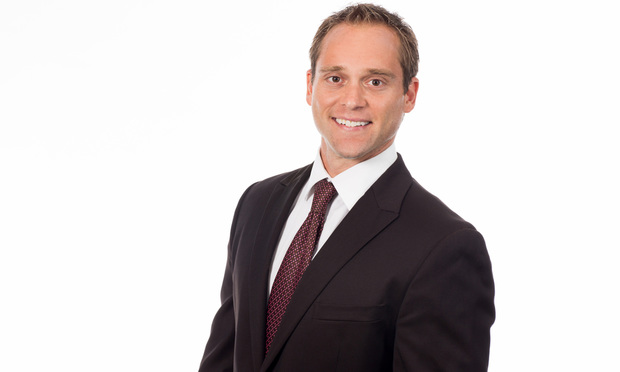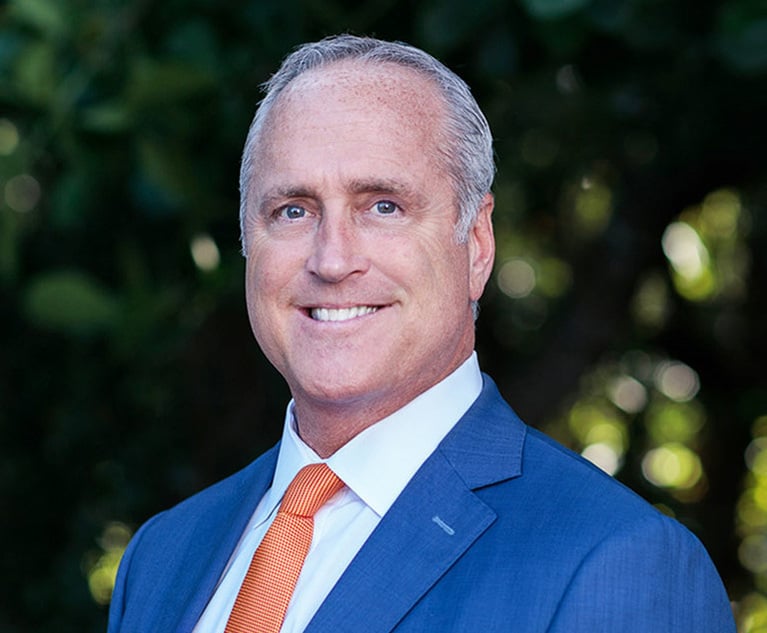Three Reasons Why Integrated Marketing for Law Firms is Money in the Bank
It's safe to say that law firm marketing and communications has a reputation for being a bit behind the times and slow to adapt to new ideas and concepts. There are a lot of reasons for this, but some of the most common are usually budget constraints and personalities that are generally just more risk adverse, especially when it comes to investing in marketing.
September 27, 2018 at 09:54 AM
7 minute read
 Josh Merkin, Vice President, rbb Communication, Coral Gables
Josh Merkin, Vice President, rbb Communication, Coral Gables
It's safe to say that law firm marketing and communications has a reputation for being a bit behind the times and slow to adapt to new ideas and concepts. There are a lot of reasons for this, but some of the most common are usually budget constraints and personalities that are generally just more risk adverse, especially when it comes to investing in marketing.
For years and years, the centerpiece of a lot law firm PR programs was media relations. These provided attorneys with tangible results they could see when their comments were included in a story or when their bylined article ran in a key trade publication. They would hear from their friends who saw them in the paper, they would put hard copies of the articles in their new business folders for pitches, they would share them around via email and frame them in their offices.
It's been a slow push, but more recently PR and marketing professionals have had luck with getting law firms to adopt some social media best practices, invest in more dynamic website and e-newsletters and even getting them to say no to buying a table at a dinner where no one from the firm shows up.
Even though progress has been made, law firm marketing can still feel very disconnected and siloed. As 2018 winds down and planning for 2019 starts, there is one concept that all marketing and communications professionals should be putting as the centerpiece for their strategies: the P.E.S.O model.
The P.E.S.O model provides firms with a fully integrated marketing approach that surrounds target audiences with multiple touch points while breaking down the tactics silos that have been prevalent for many years. Equally as important is that this model helps ensure key message consistency across all communications.
While integration is not necessarily a new concept, P.E.S.O has started to become more popular for marketers in professional services. In fact, earlier this year at the Legal Marketing Association's national conference, it was mentioned during several of the breakout sessions and it has become increasingly used at PR agencies that are finding this to be more robust and strategic way to service their law firm clients.
To fully understand the P.E.S.O model, let's start with a breakdown of the acronym:
- Paid—advertising (digital and traditional), sponsorships
- Earned—news media stories, coverage, bylined articles, op-eds, etc.
- Shared—social media
- Owned—website, newsletters, speaking engagements, awards programs
Its likely that most professional service firms, especially the larger, more sophisticated ones are using all of the tactics above in one way or another. But, are they using them to complement each other or are they disconnected?
Here are three reasons law firm marketers and communications professionals should be utilizing the P.E.S.O model for their marketing programs:
More bang for your buck—With attorneys already strapped for time, getting them to participate in a PR program can sometimes be a challenge because they want to make sure their time is being well spent. But with the P.E.S.O model, just one piece of effort can turn into multiple types of content useable across all marketing platforms. For example, if a shareholder drafts a bylined article for an earned media placement, that same article can then be used for a LinkedIn blog post, website and bio updates, video and e-blast. Additionally, you can draft social media posts promoting the piece of content and even use the media placement for native advertising. All of these results join together to form one cohesive marketing push and it all came from just one unique piece of content. Likewise, because marketing budgets tend to be smaller for law firms than for bigger consumer companies, it becomes even more important that any investment be stretched as wide as possible. The P.E.S.O model helps make this happen and whether you are an in-house CMO or work in an agency, smart and strategic planning about how to utilize your resources will bring greater returns and buy-in from your board of directors or executive management team.
Measurement and ROI—One of the biggest pieces of feedback often heard in law firm marketing, especially for a program heavy on media relations, is how can we measure the PR investment and ROI in terms of new business. Considering the days of measuring advertising equivalency are long gone (hopefully), in some cases measurement can be an ongoing challenge. Sure, you can measure key message penetration or share of voice, but those don't speak to the bottom line, which is exactly what professional service firms are most interested in. We all know that data has become the cornerstone of nearly all businesses and the PESO model really provides some valuable key learnings specific to analytics. Since a lot of the components are supported through digital marketing, measurement can be a lot easier and more strategic. For instance, if your KPIs are focusing on driving people back to your website so you can capture their information and remarket them, digital marketing tactics provide great opportunities to accomplish this and measure your efforts through open rates on e-blasts, time spent on site pages, form fills and content downloads. These insights also provide a chance to evaluate the content you are creating to determine which types of topics are most effective with your target audiences and which ones aren't worth the time investment. This level of detail can provide internal marketing teams with the ammunition they need to justify their budget spends and also potentially manage the personalities of executive management teams who may deem some things more important than others despite not having the analytics to back it up.
Smart strategy lets you say “no”—Law firm marketers know that it can be sometimes difficult to stay the course, especially when you are handling the demands of a lot of attorneys with differing interests. Whether you are in-house or with an agency, there are times when you are approached about paying for something or participating in something that doesn't align with your firm's overall marketing goals. Since the P.E.S.O model provides a clear and cohesive marketing strategy, it also makes it a lot easier for marketers to be empowered and say no to executive demands and recommendations. Again, with the idea being that the P.E.S.O model means utilizing an integrated marketing strategy that requires a commitment of resources, anything that sits outside of this strategy may not be the best use of the firm's budget and time which can be a great excuse to keep people focused on the tasks at hand.
Law firm marketing and communications have come a long way, but as budget accountability and business results become even more important, integration is a key component that should be utilized in building out any strategy and program. Marketers would be naïve to think the P.E.S.O model doesn't require more investment of both budget and time to execute the tactics, but the payoff can be substantial when done correctly and with the right partners.
This content has been archived. It is available through our partners, LexisNexis® and Bloomberg Law.
To view this content, please continue to their sites.
Not a Lexis Subscriber?
Subscribe Now
Not a Bloomberg Law Subscriber?
Subscribe Now
NOT FOR REPRINT
© 2025 ALM Global, LLC, All Rights Reserved. Request academic re-use from www.copyright.com. All other uses, submit a request to [email protected]. For more information visit Asset & Logo Licensing.
You Might Like
View All

Don’t Forget the Owner’s Manual: A Guide to Proving Liability Through Manufacturers’ Warnings and Instructions
5 minute read

Trending Stories
- 1No Two Wildfires Alike: Lawyers Take Different Legal Strategies in California
- 2Poop-Themed Dog Toy OK as Parody, but Still Tarnished Jack Daniel’s Brand, Court Says
- 3Meet the New President of NY's Association of Trial Court Jurists
- 4Lawyers' Phones Are Ringing: What Should Employers Do If ICE Raids Their Business?
- 5Freshfields Hires Ex-SEC Corporate Finance Director in Silicon Valley
Who Got The Work
J. Brugh Lower of Gibbons has entered an appearance for industrial equipment supplier Devco Corporation in a pending trademark infringement lawsuit. The suit, accusing the defendant of selling knock-off Graco products, was filed Dec. 18 in New Jersey District Court by Rivkin Radler on behalf of Graco Inc. and Graco Minnesota. The case, assigned to U.S. District Judge Zahid N. Quraishi, is 3:24-cv-11294, Graco Inc. et al v. Devco Corporation.
Who Got The Work
Rebecca Maller-Stein and Kent A. Yalowitz of Arnold & Porter Kaye Scholer have entered their appearances for Hanaco Venture Capital and its executives, Lior Prosor and David Frankel, in a pending securities lawsuit. The action, filed on Dec. 24 in New York Southern District Court by Zell, Aron & Co. on behalf of Goldeneye Advisors, accuses the defendants of negligently and fraudulently managing the plaintiff's $1 million investment. The case, assigned to U.S. District Judge Vernon S. Broderick, is 1:24-cv-09918, Goldeneye Advisors, LLC v. Hanaco Venture Capital, Ltd. et al.
Who Got The Work
Attorneys from A&O Shearman has stepped in as defense counsel for Toronto-Dominion Bank and other defendants in a pending securities class action. The suit, filed Dec. 11 in New York Southern District Court by Bleichmar Fonti & Auld, accuses the defendants of concealing the bank's 'pervasive' deficiencies in regards to its compliance with the Bank Secrecy Act and the quality of its anti-money laundering controls. The case, assigned to U.S. District Judge Arun Subramanian, is 1:24-cv-09445, Gonzalez v. The Toronto-Dominion Bank et al.
Who Got The Work
Crown Castle International, a Pennsylvania company providing shared communications infrastructure, has turned to Luke D. Wolf of Gordon Rees Scully Mansukhani to fend off a pending breach-of-contract lawsuit. The court action, filed Nov. 25 in Michigan Eastern District Court by Hooper Hathaway PC on behalf of The Town Residences LLC, accuses Crown Castle of failing to transfer approximately $30,000 in utility payments from T-Mobile in breach of a roof-top lease and assignment agreement. The case, assigned to U.S. District Judge Susan K. Declercq, is 2:24-cv-13131, The Town Residences LLC v. T-Mobile US, Inc. et al.
Who Got The Work
Wilfred P. Coronato and Daniel M. Schwartz of McCarter & English have stepped in as defense counsel to Electrolux Home Products Inc. in a pending product liability lawsuit. The court action, filed Nov. 26 in New York Eastern District Court by Poulos Lopiccolo PC and Nagel Rice LLP on behalf of David Stern, alleges that the defendant's refrigerators’ drawers and shelving repeatedly break and fall apart within months after purchase. The case, assigned to U.S. District Judge Joan M. Azrack, is 2:24-cv-08204, Stern v. Electrolux Home Products, Inc.
Featured Firms
Law Offices of Gary Martin Hays & Associates, P.C.
(470) 294-1674
Law Offices of Mark E. Salomone
(857) 444-6468
Smith & Hassler
(713) 739-1250






